Home . Mission
statement . Chairman's statement . Board membership . Media program . Youth and education program Arts and sport program . Commercial and the professions program . Civil society program . Administrative overview . Appendix A: Financial statements . Appendix B:
ARTS AND SPORT PROGRAM
The Institute aims to cultivate in Indonesia and Australia an appreciation of the quality, diversity and sophistication of the visual and performing arts in the two countries, and to develop a market in indonesia for Australian visual and perfoming arts and Australian expertise. It also aims to encourage relations between Australian and Indonesian sports people and organisations.
In addition to sponsorship of in-country arts residencies, the Institute supported a range of successful collaborative projects in the arts inspired in many cases by recent social and political change in Indonesia. The sport program was deferred due to the security situation in Indonesia and following consultation with Indonesian sports officials.
AWAS! Recent art from Indonesia
The AWAS! exhibition, jointly curated by Damon Moon (Australia), Dr Dwi Marianto and Mella Jaarsma (Indonesia), and Alexandra Kuss (Germany), toured Indonesia and Australia before travelling to Germany, Japan and The Netherlands. The exhibition, showing the work of 14 contemporary Indonesian artists/activists, emerged from the social, political and economic changes in Indonesia following the resignation of President Soeharto in May 1998.
AWAS! was the first exhibition from Indonesia of its kind and exposed Australian audiences to the diversity and dynamism of Indonesian artists responding to dramatic political and social transformation.
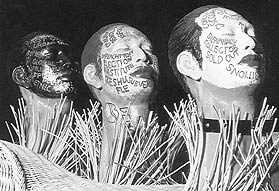 |
| Who wants to take me around? Nindityo Adipurnomo, from AWAS! Recent art from Indonesia during its Australian tour. Curated by Damon Moon, Dr Dwi Marianto, Mello Jaarsma and Alexandra Kuss. |
In Australia, AWAS! attracted several excellent reviews in the media and was seen by around 10 000 visitors at the following galleries: Australian Centre for Contemporary Art in Melbourne, the Contemporary Art Space in Canberra, the Ivan Dougherty Gallery in Sydney, the Cairns Regional Gallery and Wollongong University Gallery.
Theft of Sita
Theft of Sita, a major AustralianIndonesian collaboration, was a highlight of the Adelaide Festival of Arts. Artistic director, Nigel Jamieson, brought together Balinese shadow puppetry and musicians with images by Mambo designer, Reg Mombassa, and music by Paul Grabowski and I Wayan Gde Yudane. Theft of Sita, transposing the great classical story of the Ramayana to contemporary Indonesia, played to large audiences and received excellent media reviews.
Theft of Sita was invited to perform at the Melbourne Festival in November 2000. Also in November, the Institute provided support for 'Music for Sita' to be performed at the Wangaratta Festival of Jazz and broadcast on Australian radio.
Jigsaw Theatre production of Kera Putih
The Institute provided sponsorship for the Jigsaw Theatre company in Canberra to showcase Julie Hanson's play, Kera Putih (The White Monkey) in Australian primary schools. Kera Putih, combines traditional and contemporary art forms of Indonesia to encourage an appreciation of Indonesia among young Australians. The performance, complemented by question time and teachers notes, tells the story of the meeting of an Australian girl and Indonesian boy and their rediscovery of the epic Ramayana story. In Canberra, the performance toured to 23 primary schools reaching 6000 children. The Melbourne tour is scheduled for early 2001.
'The Kera Putih performance assisted the LOTE (language other than English) Indonesian program by setting the scene of some of the cultural aspects of Indonesia, the masks, costumes, musical instruments ... An excellent and enjoyable performance.'Teacher evaluation.
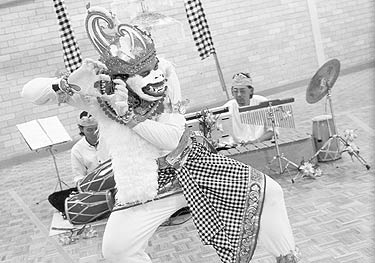 |
| Jigsaw performance of Kera Putih at a Canberra primary school. |
AsiaPacific Triennial of Contemporary Art, Queensland Art Gallery
The triennial, including an exhibition, conference, publications, visitor and education programs, documentary films, research and online access, was held from 9 September 1999 to 26 January 2000. The Institute's substantial contribution facilitated the presence of contemporary artworks from Indonesia, and the participation of Indonesian artists and curators.
Indonesian artists included Dadang Christianto, S Teddy D, Nia Fliam, Agus Ismoyo, Mella Jaarsma, Moelyono and Tisna Sanjaya. Indonesian curators included Dr Dwi Marianto and Jim Supangkat.
The triennial attracted a record audience of 155 000 to the Queensland Art Gallery, 1.3 million hits to the web site, and captured national and international media attention.
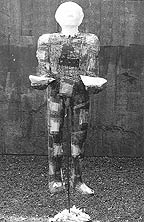 |
Api di bulan Mei 1998 Performance and installation comprising 47 burned papier-mache figures, Dadang Christianto, at the Queensland Art Gallery Asia Pacific Triennial, 10 September 1999. |
Trepangan indigenous opera, Festival of Darwin
Trepang, an indigenous Australian opera about the meeting in pre-colonial times of the people of Makassar in Sulawesi and the Yolngu of the Northern Territory, was performed at the Festival of Darwin in September 1999.
Artistic Director and former Asialink residency recipient, Andrish Saint-Clare, produced Trepang, a highlight of the Festival. Six actors and musicians from Sulawesi, Indonesia, teamed up with ten from Galiwin'ku, Echo Island, Northern Territory, to present the story of a prahu's voyage to Australia during the north-west monsoon, and of contact and trade with the Yolngu. The story was told through a series of songs and dances from both cultures and revolved around the themes of community development and resource management. The four performances were enjoyed by large audiences (over 70 000) and received excellent reviews. ABC TV has agreed to screen a documentary in 2000.
'While the opera was sung in Macassarese and Yolngu Matha, which includes a repertoire of some 450 shared words ... even to outsiders ... the story was clear in the detailed performances; we just missed out on lots of jokes that had the large Aboriginal audience in stitches throughout.'Suzanne Spunner in RealTime, December 1999January 2000.
Arts residencies in Indonesia
The Institute sponsored three Asialink residencies in Indonesia for Australian artists in 19992000.
Australian painter Peter Adsett was hosted by Yogyakarta-based batik designer and painter, Ardiyanto. During the six-month residency, Mr Adsett painted an exhibition series on the theme of place as a sacred area. His exhibition, 'The Seven Winds of Merapi', was launched at the Ardiyanto Gallery and attracted positive public and press comment.
'The benefits of such a residency are immeasurable ... We met so many wonderful people, some who have become good friends, and we saw some inspiring art and cultural events.'Peter Adsett report to Asialink.
Dancer and choreographer Wendy McPhee was hosted by the Institut Seni Indonesia in Yogyakarta where she taught and participated in workshops in traditional and western performance techniques.
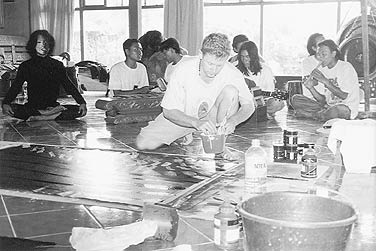 |
| Asialink artist in residence, Mr Peter Adsett, painting the 'Seven Winds of Merapi' in Kartika Affandi's studio accompanied by live gamelan music. |
Producer of Arimba Cultural Exchange, Arif Hidayat, worked with Farabi Music School in Bandung during his residency. On his return to Australia, Mr Hidayat worked on the production of Theft of Sita and the Australian tour of the Indonesian jazz-fusion band, Krakatau.
Ceramic pottery residency in Bali
Australian potter, Brian Alexander, was sponsored by the Institute to instruct members of the government Board for the Research and Implementation of Technology (BPPT) and local ceramic producer, Bali Moon, in the development of new technology and methods to increase the productivity of ceramic artists. Mr Alexander's residency in Bali attracted positive publicity and led to the adoption of new technologies.
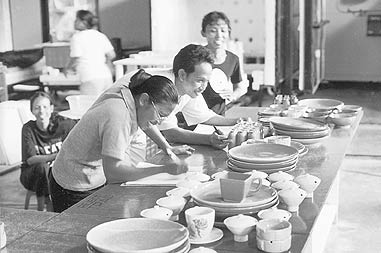 |
| Ceramic Art and Pottery in Indonesia, project developed during Brian Alexander's residency in Bali. |
Spiros Rantos and Brachi Tilles musical duo
In collaboration with the Jakarta performing arts centre (Gedung Kesenian), the Institute co-sponsored a tour by the Queensland violin-piano duo, Spiros Rantos and Brachi Tilles. The duo performed in Jakarta, Bandung and Surabaya, and ran workshops for music teachers and students.
AUSTRALIA INDONESIA INSTITUTE ANNUAL REPORT 19992000
Home . Mission statement . Chairman's statement . Board membership . Media program . Youth and education program Arts and sport program . Commercial and the professions program . Civil society program . Administrative overview . Appendix A: Financial statements . Appendix B:
